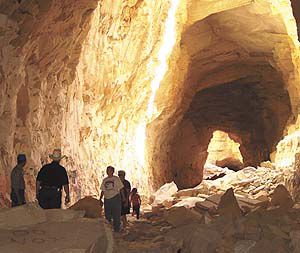| Members of the Emery County Historical Society appear very small in comparison to the opening in the main tunnel at MK Tunnels. |
The Emery County Historical Society went on a field trip recently and visited the MK Tunnels. Mervin Miles began the tour with a little history of the tunnels. “The general contractor for this project was the Department of Defense. The government wanted to test the rock for stability and feasibility for the building of a storage site. This began in the late 40s and continued until the mid 50s,” stated Miles.
“The tests were to determine if the rock in this area could withstand a bomb blast. Many tons of TNT were used to create the big tunnel. It goes back into the mountain about 300 feet with an off-shoot tunnel which is about 200 feet long. Several local men were involved in this project including, Jim Peacock, Lyle Crawford, Stewart Snow, and many others.
“In the 50s, when the crews were cleaning up the area, an Emery County gully washer came down and the flood waters rushed into the holes on the surface of the tunnel. One man was drowned, I’m not sure of his identity, and many pieces of equipment were also lost in the flood.
“In the Buckhorn, the powder magazine for this project was built. Further up the Buckhorn is where the camp was located with the living quarters for the people.
“This area has been considered a public safety hazard, due to the large holes in the top of the tunnels. The Bureau of Land Management has decided to reclaim the area to eliminate the dangerous situation. Following the blasts, it was determined that the rock in this area was too soft for the purpose of storage. The testing moved into Colorado and found a site suitable for the purpose and that location is NORAD today.
“For the reclamation of the project, the BLM has decided to fill in two of the three holes with small indentations remaining for the public to be able to visualize the holes. One hole will have grating installed so the hole remains visible. The opening of the main tunnel will have recessed bars installed to allow visitors to see into the tunnel, but not have access into the unsafe areas. This reclamation project will resolve the safety and liability issues for the BLM,” said Miles.
The group walked into the tunnels and looked over the site, after which they went to the powder magazine location. It was the general consensus of the group to request the main opening of the tunnel be left open for approximately 25 feet before the installation of the bars. They felt this distance would still be safe and yet allow visitors to the area a better feeling of the immense size of the tunnel.
For the reclamation of this site, the BLM has contacted the Division of Oil, Gas and Mining for the engineering and completion of the project. As a part of the reclamation project, the BLM has expressed the need for interpretive, informational kiosks in the area to give visitors the history of the tunnels. The historical society suggests the kiosk location to be near the powder magazine with directions and pathways to the tunnel.

